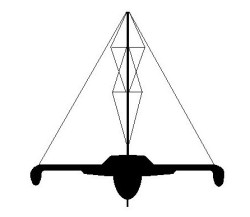Trimaran, Condor
40' x 28' x 3 Tons
18-Ft. Dia. Sea Anchor
Force 7-8 Conditions
File S/T-4, obtained from Jack Hunt, Apollo Beach, FL. - Vessel name Crystal Catfish IV, hailing port Apollo Beach - Trimaran, designed by Condor Ltd., LOA 40' x Beam 28' x Draft 8' (20" board up) x 3 Tons - Sea anchor: 18-ft. Diameter Para-Tech on 400' x 1/2" nylon three strand tether and bridle arms of 80' each, with 5/8" galvanized swivel - No trip line - Deployed during passage of low system in deep water in the Gulf of Mexico about 125 miles WNW of Tampa with winds of 30-40 knots and seas of 15 ft. - Vessel's bow yawed 10° - Drift was estimated to be about 2 n.m. during 12 hours at sea anchor.
Jack Hunt is a veteran of the 1980 and 1984 OSTARs (Observer Singlehanded Trans-Atlantic Race) in which he sailed a 31-ft. monohull named Crystal Catfish III. After making the switch to a lightweight, fast multihull, Jack ended up using a Para-Tech sea anchor during the 500-mile single-handed qualifying run, in preparation for the 1988 OSTAR. In a related article which appeared in the January/February issue of Multihulls, Jack describes conditions in the Gulf of Mexico in the winter as "a battleground of warm and cold fronts, locked in fifteen-round bare-knuckled battles for supremacy, much like the English Channel in June, except the waves in the Channel have the decency to come from the same direction as the wind." Here is a transcript of the DDDB feedback your author obtained from Jack:
Two things caught me by surprise in the twelve hour winter ride [at sea anchor] in the Gulf. First, how much stretch there is in nylon rode. Chafe protection is a must. Second, the "G-forces" which result from the boat being lifted up on a wave top (increased G-force) and then let down into a trough (reduced G-force), much as one would feel on a roller coaster. These forces are a characteristic, I suspect, of the lightweight multihull configuration, having nothing to do with the para-anchor and not at all a problem, just surprise. Because I am alone I do not use a trip line; not enough hands. Instead, I winch the rode in until the para-anchor is within reach with a boat hook and then pick up a shroud line. All of which nets me quite a mess hurriedly stuffed into a bag on a trampoline, so I can get back to tending the suddenly underway boat. Re-folding the chute for its next use presents me with the "one-legged sailor at an ass-kicking contest" scenario. Consequently I have acquired a parachute for use in between the time I haul out the para-anchor and can get it re-folded, if something should develop. The [aerial] parachute is not nearly as rugged as the para-anchor, however, so I remain motivated to work out a more reliable re-folding routine.
The only question remaining for me is, "why didn't I use a para-anchor all those years I had a monohull?" Probably had to do with the false heroism of getting the hell kicked out of me and my boat while hove-to. I should have had this para-anchor years ago.
